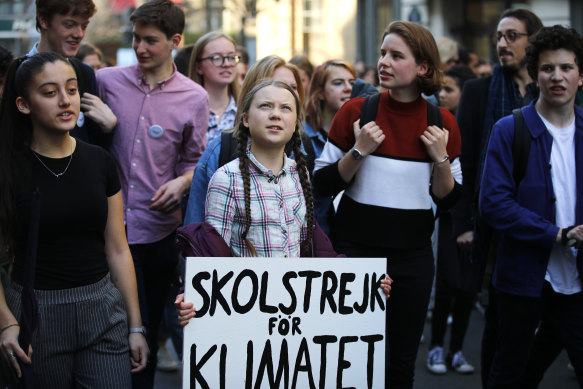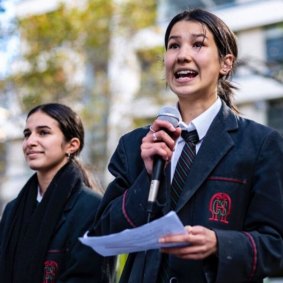It’s a snapshot from the past: a beaming Ella Simons, 12, in a crowd of thousands of schoolchildren marching for climate action through the sunlit streets of Melbourne, capturing the hope and elation of that day in 2018.
A year later Simons helped lead up to 100,000 young people, inspired by Swedish climate action wunderkind Greta Thunberg, in a march through the CBD – one of largest environmental protests Melbourne has seen.
Six years on, the Balaclava teenager – who is still not old enough to vote – is a seasoned activist.
The Age caught up with several young people who took part in the 2018 school strike, which sharply divided political and community opinion at the time, finding contrasting attitudes about their impact and legacy.
For Simons, now 17, and her friend Anjali Sharma, the protests were a springboard to more high-profile activism. However, for Siena Rigazzi, the excitement and idealism of those big days out have given way to disillusionment that, in the end, little was achieved.
But back in 2018, it seemed to many of the striking students that this was their moment.
For Simons, it was her love of the natural world – and her fear of the havoc climate change might wreak – that led her to abandon the classroom that day and take to the streets.
Students waved their homemade cardboard signs and chanted, while politicians called for them to go back to school. Matt Canavan, then the federal resources minister, claimed the protest would only teach the young people “how to join the dole queue” – which only made them more determined.
“It was such a turning point moment of like, ‘Oh my god, you can be part of something that’s way bigger than yourself,’” Simons said.
“That feeling of being on the street chanting, surrounded by thousands of people in that first strike … I was like, ‘This is incredible.’”
After that first protest, Simons joined an environment club at school and, in 2019, went to an Australian Youth Climate Coalition event, where she met a 14-year-old Sharma.
“Our journey to activism started together,” Simons said.
Sharma was jolted to action by the impact of heatwaves and floods on extended family in India and increasingly extreme weather events in Australia.
She started seeking out videos about climate change and found an ad looking for protest organisers. “I begged my mum to take me along,” Sharma said.
She and Simons would go on to be key organisers in the School Strike 4 Climate (SS4C) movement.
They helped plan the next strike in 2019 when, according to organisers, 100,000 people brought Melbourne’s CBD to a standstill. They banged drums, chanted and sang as they made their way to the steps of Parliament House.
“I never felt so empowered and so proud to be a part of a cause in my life, that day in 2019 … everything that I’ve gone on to do would not have happened if I hadn’t had those moments,” Sharma said.
Simons was in “full disbelief” about the number of people who attended the rally. “I remember thinking, ‘How is this possible?’” she said.
“It was just the most insane feeling to be surrounded by all these people … I had been there and helped organise that. It was incredible.”
Both continued to dedicate time to SS4C, launching an online version in 2020 when the pandemic hit. They tried to revive the strikes in 2021.
“Ella and I led around 25,000 people – which was nowhere near the 100,000 we got in 2019 – but we were still very proud of it,” Sharma said.
Now 20, Sharma is still working on climate action – but has taken her fight to the courts and corridors of power.
She’s studying full-time and assisting with a bill that aims to enshrine into federal law a ministerial obligation to consider the impact of the climate crisis on children’s health and wellbeing.
In 2020, she was the lead litigant in a federal court case that ruled the country’s environment minister had a duty of care to protect children and the environment when assessing fossil fuel projects. That ruling was overturned two years later by the full bench of the Federal Court.
“We’ve had a lot of success bringing young people, especially people who were disillusioned after the school strike movement, back to the table,” Sharma said.
Simons – now in her final year of high school – has stepped back from her role at the organisation that brought her so much. Instead, she’s working on a campaign to lower the voting age to 16.

Greta Thunberg leading French students through Paris in 2019.Credit: AP
Not everyone from the movement is as positive. Siena Rigazzi says she learnt how unjust the political system can be.
She got involved in the rallies when she was 15, organising school walkouts calling for climate action and protesting against Australia’s treatment of refugees.

A 17-year-old Siena Rigazzi speaking in 2020.
Friends and family were supportive, but some questioned what the protests would achieve.
At the time, Rigazzi argued they would show popular support for action. She was “initially elated” during the massive 2019 rally and, inspired by Thunberg, believed she could help bring about change.
“Being out on the streets with over 100,000 people, voicing our united discontent, made me believe that change was possible,” she said. “Surely, the government couldn’t deny that this is what the people want?”
But Rigazzi’s attitude changed following the initial strikes.
“Being part of a movement so widely supported that achieved so little shattered my belief in the state of our democracy,” she said. “Everything I have continued to see and learn since has not only been heartbreaking – it has been dystopian.”
While she doesn’t regret her involvement, Rigazzi said nothing being done now – by parliament, the media, universities, courts or police – would “put people and the planet over profits”.
“The students of SS4C tried, and were successful, at engaging in every avenue of legal political change that supposedly exists within a democracy,” she said.
“We were met with no adequate response. I ask now: ‘What are we expected to do?’”
Despite this, she hasn’t given up. She still organises protests over weapons manufacturing and has advocated for the Duty of Care Bill.
Get to the heart of what’s happening with climate change and the environment. Our fortnightly Environment newsletter brings you the news, the issues and the solutions. Sign up here.